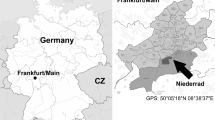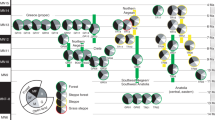Abstract
THE rapid radiation of angiosperms during the Late Cretaceous has been thought to reflect their rise to vegetational dominance1–3. The number of species in a clade and its vegetational importance are not necessarily related, however. Quantitative studies of the recently discovered Big Cedar Ridge flora, found preserved in situ in a mid-Maastrichtian volcanic ash in central Wyoming, USA, reveal that dicotyledonous angiosperms accounted for 61% of the species but constituted just 12% of vegetational cover. Dicots, many of which appear to have been herbaceous, were abundant only in areas disturbed just before burial. By contrast, free-sporing plants were 19% of the species but 49% of cover. The only abundant and ubiquitous angiosperm was a single species of palm (about 25% of cover). A comparably low abundance of dicots was found in two other nearly contemporaneous floras buried by volcanic ash, whereas coeval floras from fluvial environments are dominated by dicots4. This shows that, even as late as the mid-Maastrichtian, in northern mid-latitudes there were areas away from streams that were not yet dominated by dicots. Despite vigorous taxonomic diversification during the previous 30 Myr3, dicots played a subordinate role in these areas of fern-dominated vegetation.
Similar content being viewed by others
References
Niklas, K. J., Tiffney, B. H. & Knoll, A. H. in Phanerozoic Diversity Patterns: Profiles in Macroevolution (ed. Valentine, J. W.) 97–128 (Princeton Univ. Press, New Jersey, 1985).
Knoll, A. H. in Community Ecology (eds Diamond, J. & Case, T. J.) 126–141 (Harper & Row, New York, 1986).
Crane, P. R. in The Origins of Angiosperms and their Biological Consequences (eds Friis, E. M., Chaloner, W. G. & Crane, P. R.) 107–144 (Cambridge Univ. Press, UK, 1987).
Hickey, L. J. Am. J. Bot. 78, 115 (1991).
Love, J. D. & Christiansen, A. C. Geological Map of Wyoming (US Geological Survey, 1985).
Harland, W. B. et al. A Geologic Time Scale 1989 (Cambridge Univ. Press, UK, 1990).
Cande, S. C. & Kent, D. V. J. geophys. Res. 97, 13917–13951 (1992).
Horrell, M. A. Palaeogeogr. Palaeoclimat., Palaeoecol. 86, 87–138 (1991).
Burnham, R. J., Wing, S. L. & Parker, G. G. Paleobiology 18, 34–53 (1992).
Greenwood, D. R. Rev. Palaeobot Palyn. 71, 149–190 (1992).
Taylor, D. W. & Hickey, L. J. Pl. Syst. Evol. 180, 137–156 (1992).
Doyle, J. A. & Hickey, L. J. in Origin and Early Evolution of Angiosperms (ed. Beck, C. B.) 139–206 (Columbia Univ. Press, New York, 1976).
Lidgard, S. & Crane, P. R. Paleobiology 16, 77–93 (1990).
Wing, S. L. & Tiffney, B. H. Rev. Paleobot. Palyn. 50, 179–210 (1987).
Swisher, C. C. et al. Science 257, 954–958 (1992).
Cebula, G. T. et al. TERRA Cognita 6, 139–140 (1986).
Samson, S. D. & Alexander, E. C. Chem. Geol. Isot. Geosci. Sect. 66, 27–34 (1987).
Steiger, R. H. & Jager, E. Earth planet. Sci. Lett. 36, 359–362 (1977).
Dalrymple, G. B. Geology 7, 558–560 (1979).
Taylor, J. R. An Introduction to Error Analysis (University Science, Mill Valley, California, 1982).
Greig-Smith, P. Quantitative Plant Ecology (Univ. California Press, Berkeley, 1983).
Lillegraven, J. A. & Ostresh, L. M. Jr in Dawn of the Age of Mammals In the Northern Part of the Rocky Mountain Interior, North America (eds Bown, T. M. & Rose, K. D.) 1–30 (Geol. Soc. Am., Special paper 243, Boulder, 1990).
Author information
Authors and Affiliations
Rights and permissions
About this article
Cite this article
Wing, S., Hickey, L. & Swisher, C. Implications of an exceptional fossil flora for Late Cretaceous vegetation. Nature 363, 342–344 (1993). https://doi.org/10.1038/363342a0
Received:
Accepted:
Issue Date:
DOI: https://doi.org/10.1038/363342a0
- Springer Nature Limited
This article is cited by
-
The delayed and geographically heterogeneous diversification of flowering plant families
Nature Ecology & Evolution (2020)
-
Feeding height stratification among the herbivorous dinosaurs from the Dinosaur Park Formation (upper Campanian) of Alberta, Canada
BMC Ecology (2013)
-
Forests frozen in time
Nature (2007)
-
On the role of microenvironmental heterogeneity in the ecology and diversification of neotropical rain-forest palms (Arecaceae)
The Botanical Review (2001)
-
Biogeography of Mesozoic leptosporangiate ferns related to extant ferns
Brittonia (2001)





